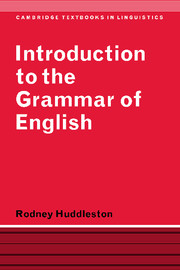Book contents
- Frontmatter
- Contents
- Preface
- Table of symbols and notational conventions
- 1 Basic concepts in grammar
- 2 The structural approach to linguistic analysis
- 3 The parts of speech
- 4 Verbs and verb phrases
- 5 The structure of kernel clauses
- 6 Nouns and noun phrases
- 7 Pronouns
- 8 Adjectives and adjective phrases
- 9 Verbs, nouns and adjectives: the boundaries between them
- 10 Adverbs, prepositions and conjunctions
- 11 Clause type
- 12 Coordination and subordination
- 13 Negation
- 14 Thematic systems of the clause
- References
- Index
5 - The structure of kernel clauses
Published online by Cambridge University Press: 05 June 2012
- Frontmatter
- Contents
- Preface
- Table of symbols and notational conventions
- 1 Basic concepts in grammar
- 2 The structural approach to linguistic analysis
- 3 The parts of speech
- 4 Verbs and verb phrases
- 5 The structure of kernel clauses
- 6 Nouns and noun phrases
- 7 Pronouns
- 8 Adjectives and adjective phrases
- 9 Verbs, nouns and adjectives: the boundaries between them
- 10 Adverbs, prepositions and conjunctions
- 11 Clause type
- 12 Coordination and subordination
- 13 Negation
- 14 Thematic systems of the clause
- References
- Index
Summary
Complements and adjuncts
Some of the initial concepts that we need in talking about the structure of kernel clauses may be introduced with reference to an example like
(1) Unfortunately, my uncle was using an electric drill at that very moment
We are taking the verb using as ultimate head of the clause, and immediate head of the VP was using (see 3.3); intuitively we can see that my uncle and an electric drill are more closely related to the VP and hence more tightly integrated into the structure of the clause than are unfortunately and at that very moment. We can think of my uncle, was using and an electric drill as combining to form, as it were, the structural ‘nucleus’ of the clause, with unfortunately and at that very moment being ‘extra-nuclear’ elements – or adjuncts as we shall call them. Adjuncts are always omissible, so that (1), for example, can be reduced to
(2) My uncle was using an electric drill
Let us now temporarily confine our attention to kernel clauses like (2), containing only nuclear elements, no adjuncts. At the first level of structure, such clauses consist of a subject followed by a predicate. The predicate we are analysing as the head, with the subject a dependent of it. The predicate position is always filled by an extended verb phrase; the subject is usually an NP, but it can also be an embedded clause or, occasionally, a PP (see 2.2).
- Type
- Chapter
- Information
- Introduction to the Grammar of English , pp. 177 - 226Publisher: Cambridge University PressPrint publication year: 1984



